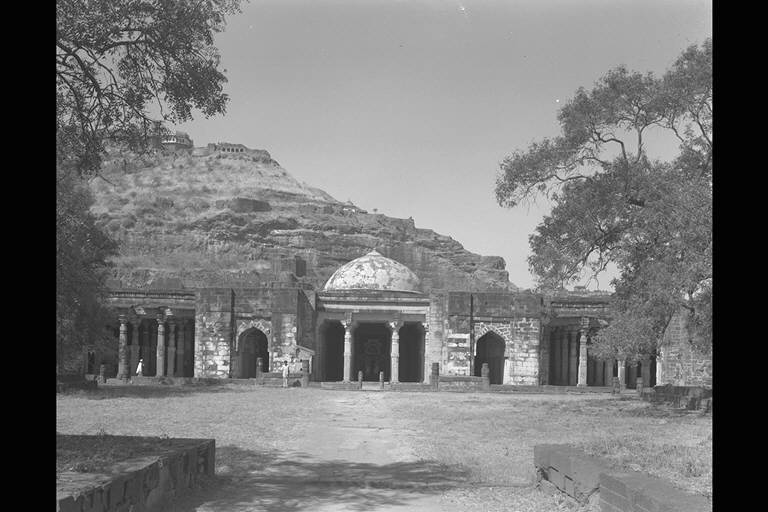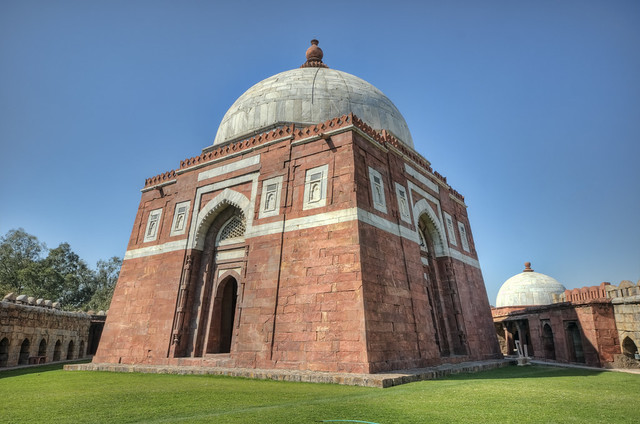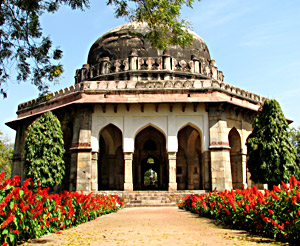Islamic architecture has encompassed a wide range of both secular and things to do with Allah like architecture styles from the foundation of Islam to the present day, influencing the design and construction of buildings and structures within the sphere of Islamic culture.
A specifically recognisable Islamic architectural style developed soon after the time of the Prophet Muhammad, developing from Roman, Egyptian, Byzantine, and Persian/Sassanid. The Indo-Islamic monuments were typical mortar-masonry works formed of dressed stones for the first time in India. The use of certain scientific and mechanical formula helped to gain greater strength and stability.
Indian architecture took new shape with the advent of Islamic rule in India towards the end of the 12th century AD. Islamic architecture soon lost its original purity and borrowed such elements from Indian architecture as courtyards surrounded by colonnades, balconies supported by brackets and decoration. Islam, on the other hand, introduced to India the dome, the true arch, geometric motifs, mosaics, and minarets. Despite fundamental differences, Indian and Islamic architecture achieved a harmonious fusion, especially in certain regional styles called the Indo-Islamic style of architecture.
The Mamluks (1206-1290)
The Mamluk Dynasty (sometimes referred as Slave Dynasty or Ghulam Dynasty) was directed into Northern India by Qutb-ud-din Aybak, a Turkic general from Central Asia. It was the first of five unrelated dynasties to rule India's Delhi Sultanate from 1206 to 1290. Aybak's tenure as a Ghurid dynasty administrator ranged between 1192 to 1206, a period during which he led invasions into the Gangetic heartland of India and established control over some of the new areas.
- Qutb Minar
- Arhai-Din-Ka Jhompra
- Chaurasi Khamba
- Ukha Mandir
- Sultan Ghari
- Iltutmish Mausoleum
- Shamsi Idgah
- Hansi Idgah
- Bayana Idgah
- Jami Masjid
- Atarkin-Ka- Darwaza
The Khaljis (1290-1320)
The Khaljis dynasty or Khalji was a Muslim dynasty of Turkic origin who ruled large parts of South Asia between 1290 and 1320. It was founded by Jalal ud din Firuz Khilji and became the second dynasty to rule the Delhi Sultanate of India. Under Ala-ud-din Khilji, the Khiljis became known for having repeatedly defended South Asia against the Mongol invasions of India.
The Khilji rulers trace their roots to Central Asia and were of Turkic origin. They settled in what is now Qalat, Afghanistan before proceeding to Delhi in India. The name "Khilji" refers to an Afghan village or town known as Qalat-e Khilji (Fort of Khilji). They were treated by others as ethnic Afghans due to their adoption of some Afghan habits and customs. As a result of this, the dynasty is referred to as a Turko-Afghan.
The Tughluqs (1320-1413)
The Tughlaq dynasty , also called "Tughraq", was a Muslim dynasty of Turkic origin which established a Delhi sultanate in medieval India. Its reign started in 1320 in Delhi when Ghazi Malik assumed the throne under the title of Ghiyath al-Din Tughluq.
- Ghiyas Al- Din Mausoleum
- Bijay Mandal
- Kota Firuz Shah
- Firauzabad: Jami Masjid
- Begampuri Mosque
- Khirki and Kalan Mosque
- Telangani Mausoleum
- Lat-ki Mosque and Fatehabad Idgah
- Gujara Mahall
- Jahaz Kothi
The Sayid and Lodi (1414-1451 and 1451-1526)
The Sayyid dynasty was the fourth dynasty of the Delhi Sultanate from 1414 to 1451. They succeeded the Tughlaq dynasty and ruled that sultanate until they were displaced by the Lodi dynasty. This family claimed to be Sayyids, or descendants of Muhammad. The central authority of the Delhi Sultanate had been fatally weakened by the successive invasion of Timur and his sack of Delhi in 1398. After a period of chaos, when no central authority prevailed, the Sayyids gained power at Delhi. Their 37-year period of dominance witnessed the rule of four different members of the dynasty.
Lodhi dynasty was made up of an Afghan tribe (Pashtun people) who ruled northern India from 1451 to 1526. It was founded by Bahlul Khan Lodhi when he replaced the Sayyid dynasty and ended after Ibrahim Lodhi was defeated by Babur from Kabulistan in the 1526 Battle of Panipat. It was during the period of the Lodhi's that the first Portuguese Armada under Vasco da Gama landed in India.











No comments:
Post a Comment